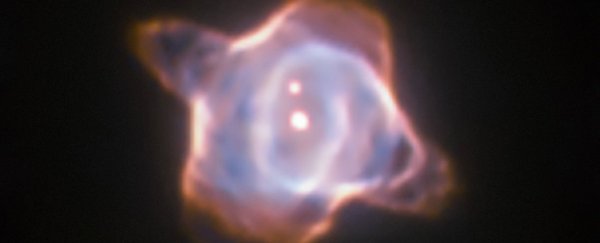Astronomers have had the privilege of witnessing the heating and cooling stages of a star's 'rebirth' for the first time. Usually, these stellar processes are too slow to be seen in a human lifespan, but SAO 244567 has proven to be no ordinary star.
An international team of researchers says that the star - located some 2,700 light-years from Earth - is now in a new cooling and expansion phase, dropping in temperature to a still-rather-toasty 50,000 degrees Celsius over the past few years.
While that's still obviously very hot, it previously reached temperatures as high as 60,000 degrees Celsius. Between 1971 and 2002, SAO 244567's surface temperature increased by almost 40,000 degrees Celsius, during which time it contracted in size.
But now the star is entering a new era - what astronomers call a 'stellar rebirth'. It's not the first time this has happened, but it's the first time we've been able to observe it.
It might also confirm a hypothesis that the same team of astronomers floated back in 2014: that SAO 244567 had experienced a helium-shell flash event, where leftover helium reignites outside the core of the star.
"The release of nuclear energy by the flash forces the already very compact star to expand back to giant dimensions - the born-again scenario," explains lead researcher Nicole Reindl from the University of Leicester in the UK.
After contracting and heating, it's now expanding and cooling, which is why the star is being talked about as being reborn, as you can see from the embedded video animation below:
Over the next few hundred years, SAO 244567 will return to its original dimensions - its younger self, so to speak - back to the same size it was around 10,300 BC, the researchers suggest.
These types of self-recycling stars are rare but not completely unheard of: basically, the helium-shell flash is thought to reignite the star's nuclear furnace for one last blast.
However, there's still a lot astronomers don't know about how these flashes and rebirths work, and SAO 244567 isn't fitting well with any current scientific models. It's certainly been moving through the rebirth process much faster than expected so far.
"We need refined calculations to explain some still mysterious details in the behaviour of SAO 244567," says Reindl. "These could not only help us to better understand the star itself but could also provide a deeper insight in the evolution of central stars of planetary nebulae."
That's what makes SAO 244567 so important to astronomers, who usually have to do a lot of complex calculations to figure out how a star has evolved over millions of years. In this case, they can study stellar evolution progressing in real time.
Nobody knows for sure how SAO 244567 is going to track from here on out, but it's definitely going to be exciting to watch.
The research has been published in the Monthly Notices of the Royal Astronomical Society.
